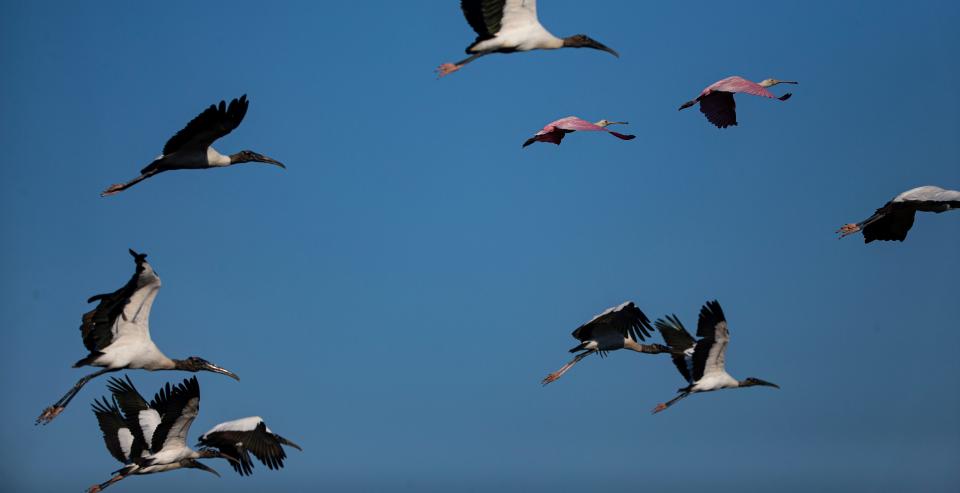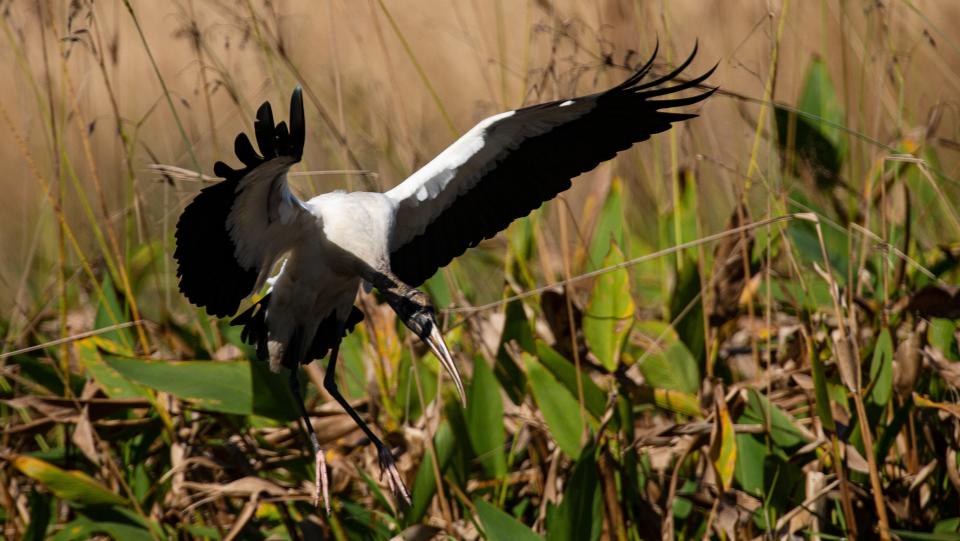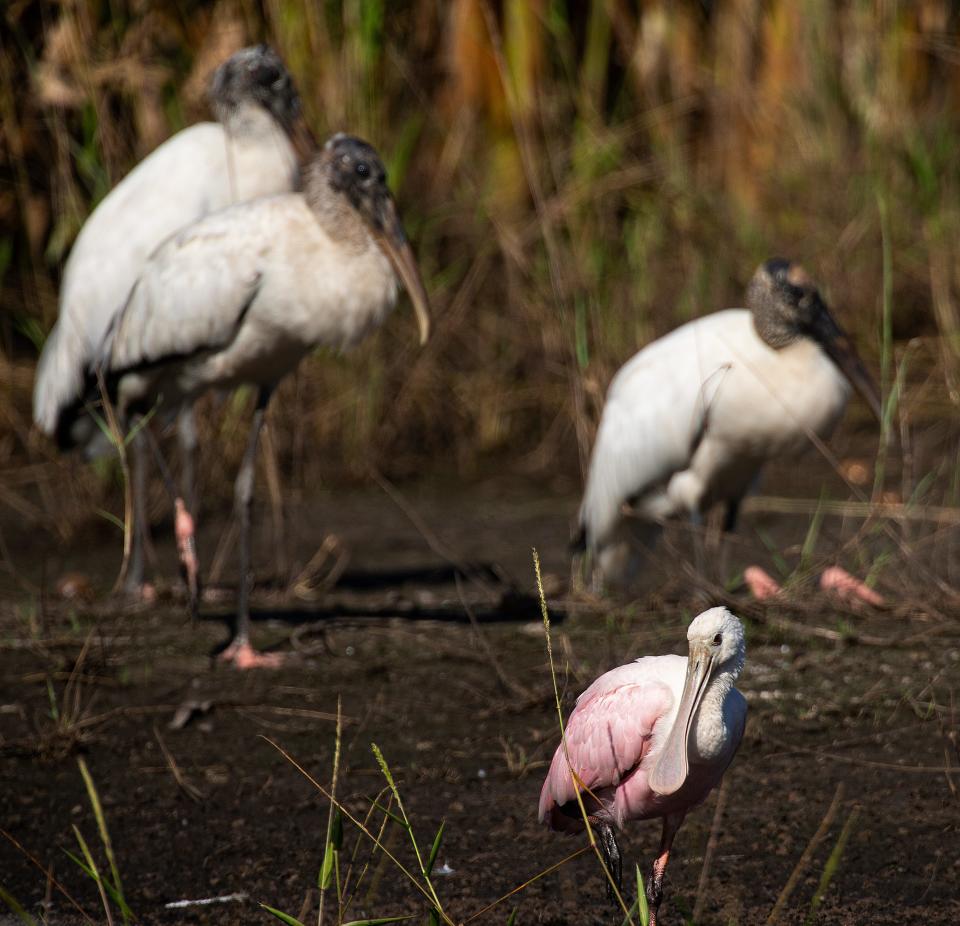It was once the largest wood stork nursery in North America. Now, it's nearly bereft of birds.
Were it the stock market or an EKG, we'd call it a crash.
But when the subject is birds, and the people doing the talking are mostly scientists, the language is more measured, yet the underlying alarm is no less acute.
Time was, thousands of wood storks nested in Audubon’s Corkscrew Swamp Sanctuary. In 1913, Audubon Society bird warden Rhett Green reported 100,000 wood storks in the swamp, Of those, likely 20,000 were nesting pairs raising some 50,000 chicks.
Contrast that with the stretch between 2004 and 2013, when wood storks only nested three times at Corkscrew, with 2,658 nesting pairs producing 4,448 fledglings.
The stork colony is the reason the sanctuary exists in the first place, says biologist Shawn Clem, research director of Audubon Florida's Western Everglades Research Center at the sanctuary.
“Wood storks had such a presence here that Audubon sent a warden to live on this property to protect them from plume hunters,” she said. Next came logging, another threat the sanctuary was designed to eliminate.

But outside the sanctuary borders loomed another menace to the birds and the system that sustained them. As humans scraped and shaped the surrounding land to suit their purposes, they changed water patterns inside Corkscrew’s 13,450 acres.
“So since it was established, our numbers have been declining,” Clem said, ”and that was concurrent with development and loss of wetlands.”
In recent decades, whole years have gone by with no nests at all in what was once the largest wood stork nursery in North America.
Climate change: Host city for 2030 Winter Olympics hasn't yet been named. Why? It may not be cold enough.
“Since the beginning of the 2000s, they’ve stopped reliably initiating nesting,” Clem said. “It used to be that every once in a while, they’d not nest, but now it’s more like every once in a while wood storks will nest.”
The federally threatened birds’ importance is overarching. Called an umbrella or an indicator species, their success is a good way to reckon the health of the system as a whole. “There’s a suite of other species ‒ alligators or otters or snowy egrets – that benefit from the same conditions,” Clem said. “If we can keep wood storks happy, we can keep the other species happy.”
A giant sucking sound in the swamp
Bad as things are, the story’s not over. Scientists, nonprofits and government agencies are working hard to yank the Corkscrew colony back from the brink.
As with many creatures evolved to depend on a specific niche, wood storks need a set of well-defined conditions to raise their families.
“They’re the most picky of the wading birds,” says Audubon Florida’s Southwest Florida Policy Director Brad Cornell. Remove even one element and things can fall apart.
Historically, to nest successfully, the storks need:
Ample summer rainfall with water levels high enough to support wood stork food: fish, frogs and other little critters they eat – up to 400 pounds each breeding season when they’re raising young, according to the International Union for Conservation of Nature’s stork, ibis and spoonbill specialist group. Heavy rains in the summer fill wetlands in and around Corkscrew, so fish, crawfish and other good wood stork food breed in high numbers.
Later in the season, wetlands need to dry enough to concentrate the food in pools so that the parents have enough for their growing families.
Enough water for alligators to swim below the nests, keeping away predators like raccoons. “One year, we watched a whole colony of baby wood storks get eaten by raccoons,” Cornell said.
Climate change: Beavers are moving into the warming Arctic. It could be a threat like 'wildfire.'

But once people moved into the surrounding area, digging agricultural and development supply wells, there’s been a giant sucking sound in the swamp, he says
Since 1958, the first year Corkscrew wood stork nesting data were recorded, the top 5 nesting years were all before 1980:
1961 (6,000 nests, 17,000 fledglings)
1960 (4,760 nests, 13,724 fledglings)
1959 and 1979 (4,505 nests, 8,910 fledglings)
1967 (3,680 nests, 7,350 fledglings)
The difference: functioning wetlands. Once humans started draining the surrounding landscape, it could no longer support as many storks. Then woody native plants like the Carolina willow started advancing, gobbling former wetlands and creating a stemmy mesh inhospitable to wood storks, alligators or much of anything else. The sanctuary has been working hard to restore the invaded land to return it to its original function.
But to tackle what Clem calls a worrisome trend, “what we need more than anything else is hydrologic restoration.”
It’s not an impossible dream, she says, but there are a lot of moving parts and now, a growing number of human neighbors with their own demands.
“Water has to be a certain height or we'll be drowning the septic tanks of our neighbors,” she said. “We need to hold water inland, but not put homes underwater.”
To that end, Audubon and the sanctuary and the South Florida Water Management District are trying to figure out why things have changed so drastically and come up with new ways to manage water in the region. Negotiations began in earnest in 2016 and three years later, they reported their findings. One key factor: the Rosen Brothers, prolific mid-20th-century developers (think Cape Coral) who in their efforts to build Golden Gate Estates in rural Collier County, dug miles of canals to drain their land.
Climate change: Weird weather hit cattle ranchers and citrus growers in 2022. Why it likely will get worse.

After the brothers went bankrupt in the late 1970s, a court order turned over those canals to Collier County, said Big Cypress Basin Administrator Lisa Koehler, and ultimately, the South Florida Water Management District, of which her basin is a part, agreed to assume management of the system.
The challenge is in Golden Gate Estates: "I have to run the canals high enough to where I can benefit the environment, plus protect our aquifer – because that’s where we’re getting our drinking water,” Koehler said. “and I’m also trying to keep water levels high enough so we don’t have really bad wildfires in the spring,” she said, “but I also can’t raise it high enough to where I’m impacting people’s septic systems And that could be a matter of inches.”
Every new home is another straw in the aquifer, she says. “And when do we reach that tipping point where there are too many straws drawing water out of the ground and Corkscrew Swamp Sanctuary is feeling that impact?”
Work to figure that out is ongoing, but improvements are already starting, Koehler said, including remote control canal operations rolled out this summer, “which is significant for us, because that means I can open that gate an inch and close it that way.” The technology saves water by saving time, she says. "Let’s say it stops raining and we write an order that says go close that gate … by the time they do it, it could be two hours, but that water’s escaping, But now, with remote control operations, we can do it right away.”
For the stork advocates, help can’t come fast enough.
“We want this fixed yesterday, but we know that’s not realistic,” Clem said. And though she’s confident, “Wildlife will respond to change, but the longer we wait for that reversal, the more we’ll have to fix.”
It's all about the water, she and Cornell say. “If we can get the wetlands back into shape,” Cornell said, “then we think we can get the wood storks back.”
Wood stork facts
Scientific name: Mycteria americana.
Other common names: Flinthead, ironhead, wood ibis.
Status: Endangered.
Range: They nest from the Carolinas, southeast Georgia, Florida, Mexico, Central and South America to northern Argentina.
Habitat: Tidal waters, marshes, streams, mangroves.
Diet: Small fish and aquatic invertebrates.
Size: 3.3 feet tall with a wingspan of 5 feet.
Description: Black bill, scaly-looking featherless head, white plumage except for short black tail and black feathers bordering the wing.
‒The News-Press archives
This article originally appeared on USA TODAY: Corkscrew Swamp, Florida wood stork drastic population decline

